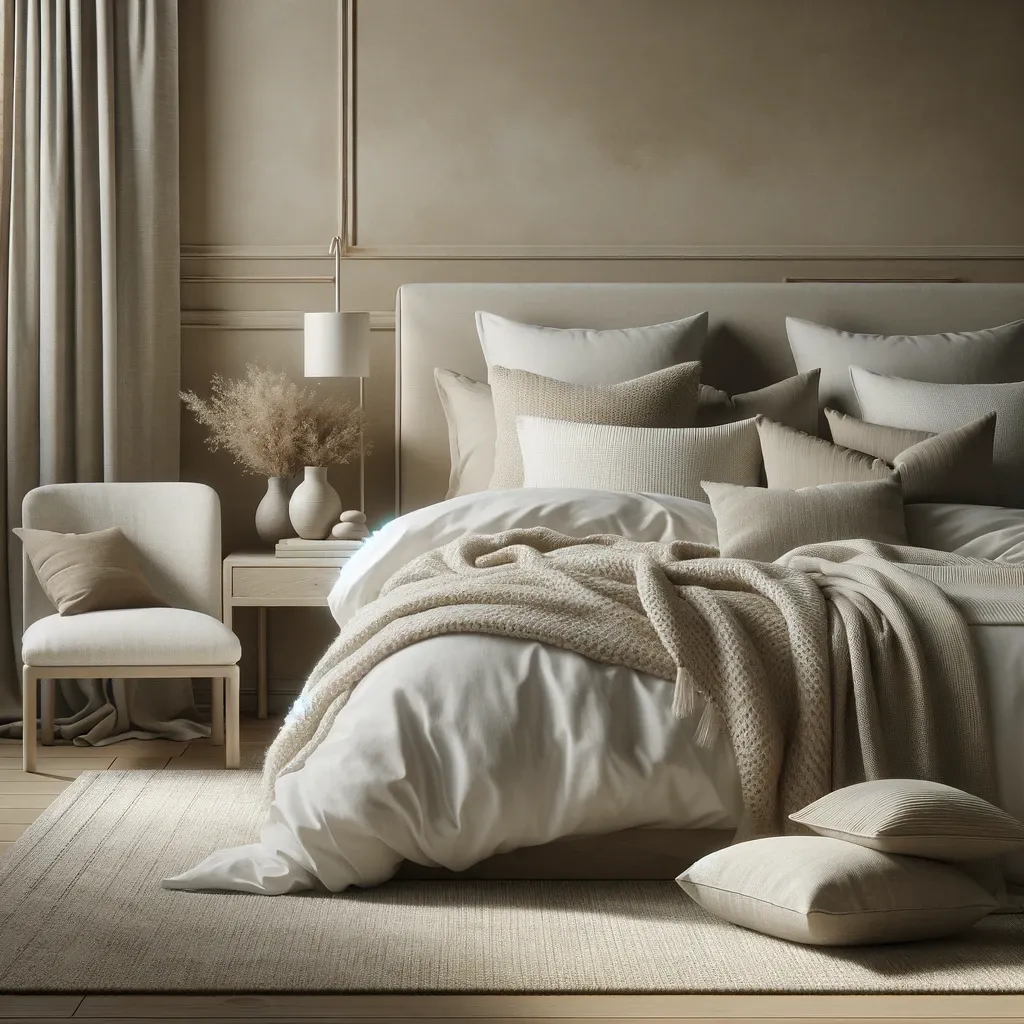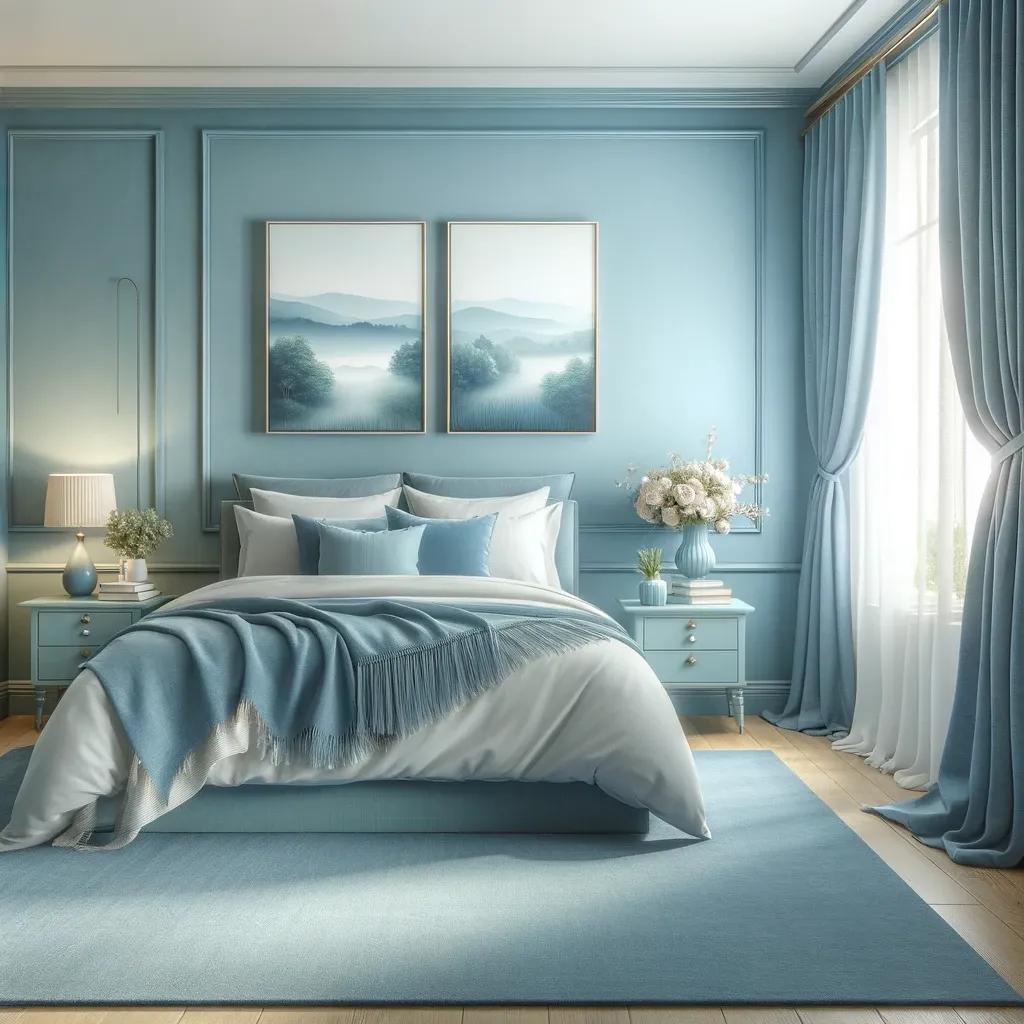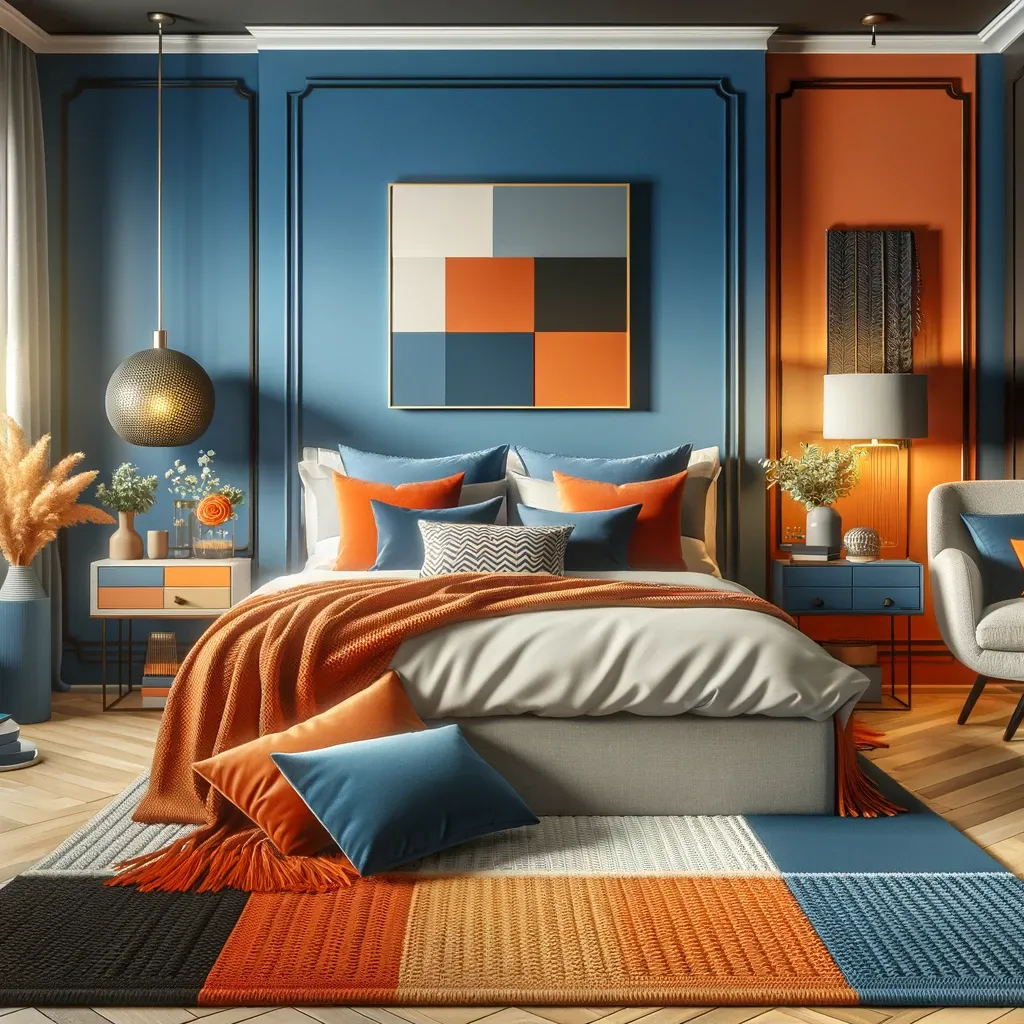Create a Serene Atmosphere: Bedroom Color Scheme Ideas
Transform your bedroom into a tranquil oasis by carefully selecting the perfect color scheme. In this article, we will explore various bedroom color scheme ideas that will help create a serene atmosphere in your personal sanctuary.
Discover how the right combination of hues can set the tone for relaxation, promote better sleep, and enhance the overall ambiance of your bedroom. From soothing pastels to sophisticated neutrals, allow your creativity to flourish as you embark on the journey of transforming your sleeping space into a calming haven
.
Neutral Color Schemes
Benefits of using neutral colors in the bedroom
Choosing a neutral color scheme for your bedroom can have numerous benefits. Firstly, neutral colors create a calming and peaceful atmosphere, allowing you to relax and unwind after a long day. These colors have a soothing effect on the mind and can help promote better sleep. Additionally, neutral colors give your bedroom a timeless and elegant look.

They are versatile and can easily be paired with different textures and patterns, allowing you to change your decor without needing to repaint the walls. Furthermore, neutral color schemes create a sense of spaciousness and openness in a room, making it appear larger and more inviting.
Popular neutral color scheme options
When it comes to neutral color schemes, there are several popular options to choose from. One classic choice is the combination of white and beige. This combination creates a clean and airy feel in the bedroom, giving it a fresh and modern look.
Another popular option is the use of various shades of gray. Gray is a versatile color that can range from light and subtle to dark and dramatic. It adds sophistication and depth to the bedroom while still maintaining a neutral base. Lastly, a combination of tan and cream creates a warm and inviting atmosphere, perfect for creating a cozy haven in your bedroom.
Tips for incorporating neutrals in your bedroom
To incorporate neutral colors in your bedroom effectively, consider the following tips.
Firstly, play with different shades of the chosen neutral color to add depth and interest to the space. This can be achieved by incorporating lighter and darker tones in your furniture, bedding, and accessories.
Secondly, experiment with textures to prevent the room from feeling flat. Mix and match fabrics, such as soft velvet, smooth silk, and cozy wool, to add visual and tactile interest. Additionally, consider adding pops of color through accent pieces like pillows, artwork, or curtains to create focal points and prevent the room from feeling monotonous.
Finally, don't forget to consider the natural lighting in your bedroom. Neutrals can be affected by different lighting conditions, so try to test out paint swatches or fabric samples in different areas of the room to see how they appear under varying levels of natural and artificial light.
Cool Color Schemes
Effect of cool colors on the bedroom atmosphere
Cool colors are known for their ability to create a tranquil and relaxing atmosphere in the bedroom. Shades of blue, green, and purple, in particular, have a calming effect on the mind, making them perfect choices for creating a serene environment.
These colors evoke feelings of serenity, tranquility, and freshness, helping to reduce stress and promote better sleep. Cool colors can also make a smaller room appear larger and more open, giving the illusion of space and airiness.
Different shades of blue for a calming effect
Blue is a popular choice for bedrooms due to its calming and serene properties. Lighter shades of blue, such as sky blue or pastel blue, can create a soft and dreamy ambiance, ideal for inducing a sense of relaxation.

Darker shades of blue, like navy or royal blue, add depth and richness to the space, creating a more intimate and cozy atmosphere. Combining different shades of blue within the bedroom decor, such as through bedding, curtains, or accent walls, can create a layered and visually pleasing effect.
Using greens and purples to create a serene environment
Green and purple are also excellent choices for creating a serene bedroom environment. Green represents nature and promotes feelings of tranquility and harmony.
Lighter shades of green, like sage or mint green, can be used to evoke a soothing and peaceful atmosphere, while deeper shades of green, like emerald or forest green, add a touch of elegance and luxury. Purple, on the other hand, is associated with spirituality and relaxation.
Light shades of lavender or lilac can create a soft and feminine ambiance, while deeper shades of purple, such as eggplant or plum, bring a sense of opulence and warmth to the space. Combining greens and purples in the bedroom decor can result in a serene and rejuvenating environment.
Warm Color Schemes
Creating a cozy atmosphere with warm colors
If you want to create a warm and cozy atmosphere in your bedroom, opting for warm color schemes is the way to go. Warm colors, such as reds, yellows, and oranges, evoke feelings of comfort, intimacy, and energy. They add a sense of warmth and coziness to the space, making it the perfect retreat during colder months or for those who prefer a more inviting environment.
Using shades of yellow for a cheerful bedroom
Yellow is a fantastic choice for creating a cheerful and sunny bedroom. Shades of yellow, like buttercream or pale yellow, can make the room feel bright and vibrant, uplifting your mood and creating a sense of happiness.
Yellow is also known to stimulate mental activity and promote a sense of positivity. However, it is essential to strike the right balance when using yellow in the bedroom, as excessive amounts of bright yellow can become overwhelming.
Consider incorporating yellow through subtle accents, such as pillows, throws, or artwork, to add a cheerful touch without overpowering the space.
Incorporating earthy tones to enhance tranquility
Earthy tones, such as shades of brown, beige, and terracotta, are perfect for creating a warm and tranquil bedroom environment. These colors are reminiscent of natural elements like soil, sand, and wood, creating a connection to the earth and fostering a sense of grounding.
Lighter shades of brown, like taupe or tan, can create a cozy and inviting atmosphere, while darker shades, such as chocolate or espresso, add a touch of luxury and sophistication.

Combining earthy tones within the bedroom decor, through bedding, rugs, and furniture, can result in a harmonious and tranquil space. Additionally, incorporating natural materials like wood or stone further enhances the earthy color scheme and adds to the overall sense of serenity.
Monochromatic Color
Schemes
Definition and advantages of monochromatic color schemes
A monochromatic color scheme involves using varying shades, tints, and tones of a single color to create a cohesive and harmonious look in the bedroom. This color scheme offers several advantages, including creating a sense of unity and simplicity in the space.
Monochromatic color schemes are visually pleasing and easy on the eyes, as they eliminate the need for contrasting colors that can sometimes be overwhelming. Additionally, monochromatic color schemes allow you to experiment with different textures and patterns within a single color family, adding depth and interest to the room.
Exploring monochromatic options like all white or all gray
One popular monochromatic option is an all-white color scheme. White represents purity and cleanliness, giving the bedroom a fresh and airy feel. An all-white color scheme promotes a sense of tranquility and simplicity, allowing you to create a serene and minimalistic atmosphere.
To prevent an all-white bedroom from looking sterile or boring, consider incorporating different textures, such as faux fur, linen, or lace, to add visual interest and depth.
Another trendy monochromatic option is an all-gray color scheme. Gray is a versatile and sophisticated color that can create various moods in the bedroom, depending on the shade chosen.
Lighter shades of gray, like dove gray or silver, can create a cool and contemporary ambiance, while darker shades, such as charcoal or slate gray, add drama and elegance. Mixing different shades of gray within the bedroom decor, through bedding, curtains, or accent pieces, can create a visually appealing and cohesive monochromatic look.
Playing with different shades and textures within a single color
When using a monochromatic color scheme, don't be afraid to play with different shades, textures, and patterns within the chosen color family.
For example, if you opt for a monochromatic blue color scheme, include various shades of blue, ranging from sky blue to navy, to add depth and visual interest. You can also experiment with different textures, such as a plush velvet headboard or a shimmery satin bedspread, to create contrast and make the room feel more dynamic.
Additionally, incorporating patterns, like stripes or polka dots, within the monochromatic color scheme can add a playful and unique touch to the bedroom decor. By embracing the versatility of shades and textures, you can create a monochromatic color scheme that is anything but dull.
Two-Tone Color Schemes
Using two contrasting colors for an impactful bedroom
A two-tone color scheme involves using two contrasting colors within the bedroom decor, creating a striking and impactful look. This color scheme allows you to play with bold and contrasting combinations, adding visual interest and personality to the space.
By combining two colors, you have the opportunity to create a unique and personalized bedroom atmosphere that reflects your individual style.
Combining black and white for a classic and timeless look
One classic and timeless two-tone color combination is black and white. The contrast between these two colors creates a sophisticated and elegant look in the bedroom. Black represents power and strength, while white symbolizes purity and simplicity.
The combination of black and white adds a touch of drama and balance to the space. Consider using black for statement pieces, such as a headboard or a nightstand, and white for larger surfaces like walls or bedding. This creates a harmonious balance between the contrasting colors and allows each one to stand out.
Experimenting with bold color combinations like red and teal
If you want to make a bold statement with your bedroom color scheme, consider experimenting with vibrant and contrasting color combinations. For example, combining red and teal can create a visually stunning and energetic environment.
Red represents passion and energy, while teal symbolizes tranquility and calmness. The combination of these two colors creates a vibrant and lively atmosphere. To effectively incorporate red and teal in your bedroom, consider using each color strategically.
For example, use red for accent pieces like pillows or artwork, and teal for larger surfaces like walls or curtains. This way, the contrasting colors can complement each other rather than compete for attention.
Complementary Color Schemes
Understanding the concept of complementary colors
Complementary colors are pairs of colors that are opposite each other on the color wheel, creating a high contrast and visually striking effect.
These color combinations can create a sense of balance and vibrancy in the bedroom, making it visually appealing and exciting. Understanding the concept of complementary colors can help you create a cohesive and harmonious color scheme in your bedroom.
Pairing opposite colors on the color wheel for balance
To create a complementary color scheme in your bedroom, pair colors that are opposite each other on the color wheel. For example, blue and orange, yellow and purple, or red and green are all complementary color pairs.
When used together, these colors create a strong visual impact and balance each other out. To avoid overwhelming the space, consider using one color as the dominant color and the other as an accent color.
For example, you can have blue walls with orange throw pillows or yellow bedding with purple curtains. This way, the complementary colors can enhance each other without overpowering the room.
Tips for using complementary color schemes without overwhelming the space
Using complementary color schemes in the bedroom can create a vibrant and visually appealing environment.
However, it is essential to follow a few tips to prevent the space from feeling overwhelming. Firstly, consider using different shades and tones of the complementary colors to add depth and balance. For example, instead of using bright primary red and green, opt for softer shades like burgundy and sage green.
This allows for a more harmonious and relaxing atmosphere. Secondly, use complementary colors strategically as accents rather than dominant colors.
For example, incorporate pops of the complementary color through accessories like pillows, rugs, or artwork, while keeping the larger surfaces more neutral or monochromatic. This creates a balanced and visually pleasing composition. Lastly, consider the proportions of each color within the room.
If one color dominates the space too much, it can create an unbalanced and overwhelming effect. Be mindful of the ratio of each complementary color to ensure a visually appealing result.
Analogous Color Schemes
Creating harmony with adjacent colors on the color wheel
Analogous color schemes involve using colors that are adjacent to each other on the color wheel. This color scheme creates a harmonious and soothing atmosphere in the bedroom, as the colors naturally blend together. Analogous color schemes are perfect for those who prefer a cohesive and understated look.

Using analogous colors like blues and greens for a tranquil atmosphere
Analogous color schemes, such as blues and greens, are ideal for creating a tranquil and calming atmosphere in the bedroom. Blue and green are adjacent on the color wheel, and when used together, they evoke a sense of nature and relaxation.
Lighter shades of blue and green, like aqua or mint, can create a refreshing and soothing ambiance, while deeper shades, such as navy or forest green, add depth and richness to the space.
Incorporating different shades of blues and greens within the bedroom decor, through bedding, curtains, or accent pieces, can create a visually cohesive and peaceful environment.
Incorporating subtle variations within analogous color schemes
To avoid a monotonous and flat look in an analogous color scheme, incorporate subtle variations within the chosen color family.
For example, if you opt for a blue and green color scheme, experiment with different shades and tones of blue and green to add depth and interest. Consider using lighter shades for larger surfaces like walls or bedding, and darker shades for accents like pillows or curtains.
Additionally, incorporating textures and patterns within the analogous color scheme can create visual interest and prevent the room from feeling too one-dimensional. Play with different fabrics, materials, or prints to add depth and excitement to the overall design.
Triadic Color Schemes
Exploring vibrant and lively color combinations
Triadic color schemes involve using three colors that are equidistant from each other on the color wheel. This creates a vibrant and lively color combination in the bedroom. Triadic color schemes can be a bit more challenging to incorporate, but when done correctly, they can result in a visually striking and energetic atmosphere.
Using three colors equidistant on the color wheel for balance
To achieve a triadic color scheme in your bedroom, choose three colors that are equally spaced on the color wheel. For example, you can use red, yellow, and blue or orange, green, and violet.
By having three equidistant colors, you ensure a balanced and harmonious composition. However, it is essential to use these colors strategically, as too much saturation or intensity can overwhelm the space.
Consider using one color as the dominant color, one as a secondary color, and one as an accent color. This way, the triadic colors can complement each other without competing for attention.
Playing with primary colors or pastel tones within a triadic color scheme
When creating a triadic color scheme, you have the option to play with primary colors or softer pastel tones.
Primary colors, such as red, yellow, and blue, create a bold and vibrant atmosphere in the bedroom. This color combination is perfect for those who want a visually exciting and energetic space.
On the other hand, using pastel tones of the triadic colors creates a softer and more delicate ambiance.
Pastel red, yellow, and blue or pastel orange, green, and violet can bring a sense of tranquility and sweetness to the room. Experiment with different hues and intensities to find the perfect balance within the triadic color scheme.
Metallic Accents
Adding a touch of luxury with metallic accents
Metallic accents can instantly elevate the look of your bedroom and add a touch of luxury and glamour.
Metallic finishes create a sense of opulence and sophistication, making the space feel more elegant and refined. Gold, silver, and copper are popular choices for metallic accents in the bedroom.
Choosing gold, silver, or copper for an elegant look
Gold is a classic choice for adding a touch of elegance to the bedroom decor. The warm tone of gold adds richness and luxury to the space, creating a sense of opulence. Silver, on the other hand, offers a more contemporary and sleek look.
The cool tone of silver adds a touch of sophistication and modernity to the bedroom. Copper, with its reddish-brown hue, adds warmth and earthiness to the space. Choosing the right metallic finish depends on the overall style and ambiance you want to achieve in your bedroom.
Experiment with different finishes, such as metallic furniture, mirrors, or accessories, to find the perfect combination that suits your taste.
Using metallic finishes on furniture, mirrors, or accessories
Incorporating metallic finishes in your bedroom can be done through various elements. Consider adding metallic accents to your furniture, such as gold or silver drawer pulls or copper bed frames.
Mirrors with metallic frames can create a focal point and add a touch of glamor to the room. Additionally, adding metallic accessories, like lamps, vases, or metallic decorative pillows, can bring a subtle sheen and enhance the overall aesthetic of the space. When incorporating metallic accents, it is essential to strike a balance.
Too much metallic can make the room feel overwhelming, so use it strategically as accents rather than dominating the entire decor.
Natural and Earthy Tones
Creating a calming and grounding environment with earthy tones
Earthy tones are perfect for creating a calming and grounding environment in the bedroom. These colors are inspired by nature and evoke a sense of tranquility and harmony. Shades of brown, beige, and green are commonly associated with earthy color palettes and can bring a natural and serene feel to the space.
Incorporating shades of brown, beige, and green for a natural feel
When incorporating earthy tones in the bedroom, consider using various shades of brown, beige, and green.
Lighter shades of brown, such as taupe or sand, create a soothing and warm atmosphere, reminiscent of sandy beaches or desert landscapes. Beige, with its neutral and versatile nature, adds a sense of calmness and simplicity to the room.
Shades of green bring the freshness of nature indoors, promoting relaxation and rejuvenation. Lighter greens, like sage or mint, create a tranquil and peaceful ambiance, while deeper greens, such as pine or olive, add depth and richness.
Combining different shades of browns, beiges, and greens within the bedroom decor, through bedding, rugs, or accessories, can create a natural and soothing environment.
Using natural materials like wood or stone to enhance the color scheme
To enhance the natural and earthy color scheme in your bedroom, consider incorporating natural materials like wood or stone. Wood furniture or flooring adds warmth and authenticity to the space, creating a connection to nature.
The natural grain and texture of wood can further enhance the earthy color scheme. Stone accents, such as a stone accent wall or a bedside table with a marble top, add a touch of luxury and sophistication while still maintaining the natural aesthetic.
Additionally, incorporating plants or floral elements within the bedroom decor can complement the earthy color scheme and bring a sense of life and vitality to the space.
In conclusion, choosing the right color scheme for your bedroom is crucial in creating a serene and inviting atmosphere. Whether you opt for neutral tones, cool colors, warm colors, monochromatic schemes, two-tone combinations, complementary colors, analogous palettes, triadic schemes, metallic accents, or natural and earthy tones, each color scheme has its unique advantages and effects on the overall ambiance of the room.
By understanding the different options available and considering your personal preferences, you can create a bedroom that reflects your style and promotes relaxation and tranquility. So go ahead, unleash your creativity, and transform your bedroom into a haven of serenity and beauty.
